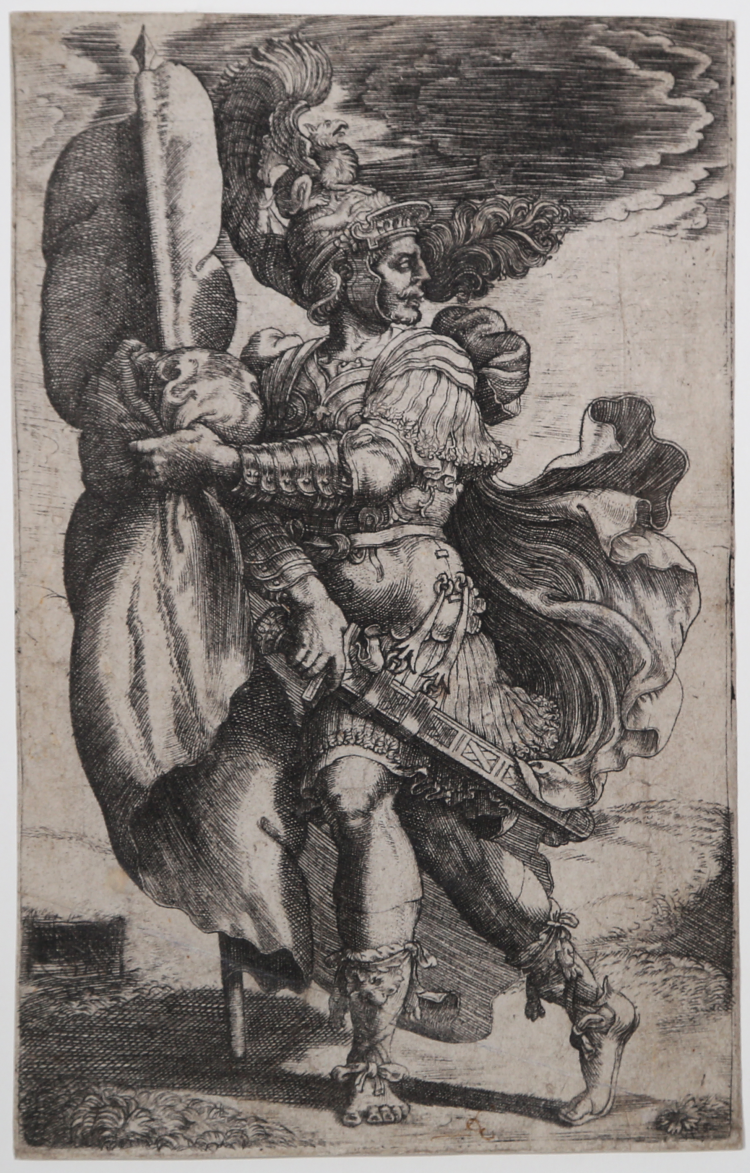



| Reference: | S39056 |
| Author | Giovanni Battista SCULTORI |
| Year: | 1536 |
| Measures: | 143 x 226 mm |


| Reference: | S39056 |
| Author | Giovanni Battista SCULTORI |
| Year: | 1536 |
| Measures: | 143 x 226 mm |
Engraving, dated 1536 and monogrammed “IBM” at lower left on a panel consisting of tick cross-hatching. Only state.
Magnificient example, printed on contemporary laid paper, trimmed close to platemark, in excellent condition.
Albricci, The engravings of G. B. Scultori, in “Print Collector – Il Conoscitore di Stampe”, n. 33-34, 1976, n.16:
“Original print according to Bartsch, reminiscent of Raimondi. It reminds us of the bombastic style of Rinaldo Mantovano. From a drawing by Giulio Romano, he painted the fresco Caesar Burns Pompey’s Letters, in which the armed figure, though flagless, closely resembles in movement that of engraving"
Etremely rare work; Albricci records only 3 examples (Pinacoteca Nazionale di Bologna; Uffizi -Firenze, Albertina).
|
Bartsch XV, 282.16; TIB, 31.23; Albricci 16; D’Arco, 12; Le Blanc, 18.
|
Giovanni Battista SCULTORI (Mantova 1503 - 1575)
|
Italian family of artists.specialized in engraving, and their association with Giorgio Ghisi, the leading Mantuan engraver of the time, led Vasari and subsequent authorities mistakenly to assume that their surname was Ghisi. Giovanni Battista Scultori worked in the studio of Giulio Romano, who was in Mantua from 1524 to 1546. Between 1536 and 1540 Scultori engraved 20 plates according to Bartsch, or 21 according to Albricci, most of which bear the monogram IBM. His style of engraving has its roots in that of Marcantonio Raimondi, probably through study with Raimondi's follower Agostino dei Musi, who was in Mantua c. 1530. The sources of the prints are almost all Scultori's own designs or drawings by Giulio Romano. Most of the subjects are Classical or military rather than religious and show a preoccupation with detail. Scultori came to engraving when he was already an accomplished draughtsman and sculptor, and his prints have a vigorous, sculptural quality with deeply cut lines that exaggerate tonal contrasts. Scultori apparently taught Ghisi, whose early work shows his influence and who engraved two plates of subjects from the Trojan Wars after his designs. He also trained his son Adamo Scultori and daughter Diana Scultori in engraving, but neither of them possessed the talent, vigour or originality of their father.
|
|
Bartsch XV, 282.16; TIB, 31.23; Albricci 16; D’Arco, 12; Le Blanc, 18.
|
Giovanni Battista SCULTORI (Mantova 1503 - 1575)
|
Italian family of artists.specialized in engraving, and their association with Giorgio Ghisi, the leading Mantuan engraver of the time, led Vasari and subsequent authorities mistakenly to assume that their surname was Ghisi. Giovanni Battista Scultori worked in the studio of Giulio Romano, who was in Mantua from 1524 to 1546. Between 1536 and 1540 Scultori engraved 20 plates according to Bartsch, or 21 according to Albricci, most of which bear the monogram IBM. His style of engraving has its roots in that of Marcantonio Raimondi, probably through study with Raimondi's follower Agostino dei Musi, who was in Mantua c. 1530. The sources of the prints are almost all Scultori's own designs or drawings by Giulio Romano. Most of the subjects are Classical or military rather than religious and show a preoccupation with detail. Scultori came to engraving when he was already an accomplished draughtsman and sculptor, and his prints have a vigorous, sculptural quality with deeply cut lines that exaggerate tonal contrasts. Scultori apparently taught Ghisi, whose early work shows his influence and who engraved two plates of subjects from the Trojan Wars after his designs. He also trained his son Adamo Scultori and daughter Diana Scultori in engraving, but neither of them possessed the talent, vigour or originality of their father.
|